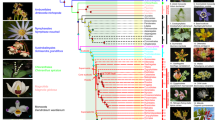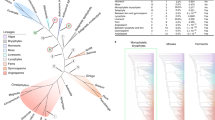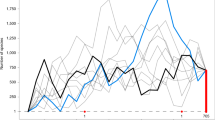Abstract
Most of the 470-million-year history of plants on land belongs to bryophytes, pteridophytes and gymnosperms, which eventually yielded to the ecological dominance by angiosperms 90 Myr ago1,2,3. Our knowledge of angiosperm phylogeny, particularly the branching order of the earliest lineages, has recently been increased by the concurrence of multigene sequence analyses4,5,6. However, reconstructing relationships for all the main lineages of vascular plants that diverged since the Devonian period has remained a challenge. Here we report phylogenetic analyses of combined data—from morphology and from four genes—for 35 representatives from all the main lineages of land plants. We show that there are three monophyletic groups of extant vascular plants: (1) lycophytes, (2) seed plants and (3) a clade including equisetophytes (horsetails), psilotophytes (whisk ferns) and all eusporangiate and leptosporangiate ferns. Our maximum-likelihood analysis shows unambiguously that horsetails and ferns together are the closest relatives to seed plants. This refutes the prevailing view that horsetails and ferns are transitional evolutionary grades between bryophytes and seed plants7, and has important implications for our understanding of the development and evolution of plants8.
This is a preview of subscription content, access via your institution
Access options
Subscribe to this journal
Receive 51 print issues and online access
$199.00 per year
only $3.90 per issue
Buy this article
- Purchase on Springer Link
- Instant access to full article PDF
Prices may be subject to local taxes which are calculated during checkout


Similar content being viewed by others
References
Kenrick, P. & Crane, P. R. The Origin and Early Diversification of Land Plants: A Cladistic Study (Smithsonian Institution Press, Washington DC, 1997).
Kenrick, P. & Crane, P. R. The origin and early evolution of plants on land. Nature 389, 33–39 (1997).
Lupia, R., Lidgard, S. & Crane, P. R. Comparing palynological abundance and diversity: Implications for biotic replacement during the Cretaceous angiosperm radiation. Paleobiology 25, 305–340 (1999).
Soltis, P. S., Soltis, D. E. & Chase, M. W. Angiosperm phylogeny inferred from multiple genes as a tool for comparative biology. Nature 402, 402–404 (1999).
Qiu, Y.-L. et al. The earliest angiosperms: Evidence from mitochondrial, plastid and nuclear genomes. Nature 402, 404–407 (1999).
Barkman, T. J. et al. Independent and combined analyses of sequences from all three genomic compartments converge on the root of flowering plant phylogeny. Proc. Natl Acad. Sci. USA 97, 13166–13171 (2000).
Rothwell, G. W. Fossils and ferns in the resolution of land plant phylogeny. Bot. Rev. 65, 188–218 (1999).
Graham, L. E., Cook, M. E. & Busse, J. S. The origin of plants: Body plan changes contributing to a major evolutionary radiation. Proc. Natl Acad. Sci. USA 97, 4535–4540 (2000).
Bremer, K. Summary of green plant phylogeny and classification. Cladistics 1, 369–385 (1985).
Duff, R. J. & Nickrent, D. L. Phylogenetic relationships of land plants using mitochondrial small-subunit rDNA sequences. Am. J. Bot. 86, 372–386 (1999).
Hedderson, T. A., Chapman, R. & Cox, C. J. in Bryology for the Twenty-first Century (eds Bates, J. W., Ashton, N. W. & Duckett, J. G.) 65–77 (Maney Publishing and the British Bryological Society, Leeds, 1998).
Mishler, B. D. et al. Phylogenetic relationships of the “green algae” and “bryophytes”. Ann. Missouri Bot. Gard. 81, 451–483 (1994).
Qiu, Y.-L., Cho, Y., Cox, J. C. & Palmer, J. D. The gain of three mitochondrial introns identifies liverworts as the earliest land plants. Nature 394, 671–674 (1998).
Hiesel, R., von Haeseler, A. & Brennicke, A. Plant mitochondrial nucleic acid sequences as a tool for phylogenetic analysis. Proc. Natl Acad. Sci. USA 91, 634–638 (1994).
Kranz, H. D. & Huss, V. A. R. Molecular evolution of pteridophytes and their relationships to seed plants: Evidence from complete 18S rRNA gene sequences. Plant Syst. Evol. 202, 1–11 (1996).
Raubeson, L. A. & Jansen, R. K. Chloroplast DNA evidence on the ancient evolutionary split in vascular land plants. Science 255, 1697–1699 (1992).
Stevenson, D. W. & Loconte, H. in Pteridology in Perspective (eds Camus, J. M., Gibby, M. & Johns, R. J.) 435–467 (Royal Botanic Gardens, Kew, 1996).
Wagner, W. H. Jr Systematic implications of the Psilotaceae. Brittonia 29, 54–63 (1977).
Manhart, J. R. Phylogenetic analysis of green plant rbcL sequences. Mol. Phylogenet. Evol. 3, 114–127 (1994).
Pryer, K. M., Smith, A. R. & Skog, J. E. Phylogenetic relationships of extant ferns based on evidence from morphology and rbcL sequences. Am. Fern J. 85, 205–282 (1995).
Sanderson, M. J., Wojciechowski, M. F., Hu, J. M., Sher Khan, T. & Brady, S. G. Error, bias, and long-branch attraction in data for two chloroplast photosystem genes in seed plants. Mol. Biol. Evol. 17, 782–797 (2000).
Hillis, D. M. Inferring complex phylogenies. Nature 383, 130–131 (1996).
Bowe, L. M., Coat, G. & dePamphilis, C. W. Phylogeny of seed plants based on all three genomic compartments: Extant gymnosperms are monophyletic and Gnetales' closest relatives are conifers. Proc. Natl Acad. Sci. USA 97, 4092–4097 (2000).
Chaw, S.-M., Parkinson, C. L., Cheng, Y., Vincent, T. M. & Palmer, J. D. Seed plant phylogeny inferred from all three plant genomes: Monophyly of extant gymnosperms and origin of Gnetales from conifers. Proc. Natl Acad. Sci. USA 97, 4086–4091 (2000).
Lewis, P. O. in Molecular Systematics of Plants II; DNA Sequencing (eds Soltis, D. E., Soltis, P. S. & Doyle, J. J.) 132–163 (Kluwer Academic, Boston, 1998).
Renzaglia, K. S., Duff, R. J., Nickrent, D. L. & Garbary, D. J. Vegetative and reproductive innovations of early land plants: Implications for a unified phylogeny. Phil. Trans. R. Soc. Lond. B 355, 769–793 (2000).
Adoutte, A. et al. The new animal phylogeny: Reliability and implications. Proc. Natl Acad. Sci. USA 97, 4453–4456 (2000).
Theissen, G. et al. A short history of MADS-box genes in plants. Plant Mol. Biol. 42, 115–149 (2000).
Hickok, L. G., Warne, T. R. & Fribourg, R. S. The biology of the fern Ceratopteris and its use as a model system. Int. J. Plant Sci. 156, 332–345 (1995).
Swofford, D. L. PAUP*. Phylogenetic Analysis Using Parsimony (*and other Methods) (Sinauer, Sunderland, Massachusetts, 1999).
Acknowledgements
We thank R. Lupia, F. M. Lutzoni, B. D. Mishler, L. Newstrom-Lloyd and S. Zoller for critical comments on the manuscript; Z. Dabich, J. Bélisle, R. Lupia and D. Kieffer for assistance in rendering Fig. 1; F. M. Lutzoni and V. A. Funk for advice on phylogenetic analyses; I. Capesius, S. Boyles, B. Goffinet, M. Hasebe, M. Kato, M. Kessler, B. D. Mishler, R. Moran, J. Shaw, W. C. Taylor, Y.-L. Qiu, D. Wall, J. Wheeler, and greenhouse managers at Humboldt State University, University of California at Davis, University of California Botanical Garden at Berkeley, New York Botanical Garden for plant material; S. W. Graham, P. S. Soltis and J. Therrien for sharing unpublished sequence data; and D. Ferguson, E. Grismer, J. Irwin and L. Sappelsa for general assistance in the initial stages of the project. This work was supported by grants from the NSF to K.M.P., A.R.S., P.G.W. and R. C., the Green Plant Phylogeny Research Coordination Group (USDA grant), and by the Pritzker Foundation Fund of The Field Museum.
Author information
Authors and Affiliations
Corresponding author
Rights and permissions
About this article
Cite this article
Pryer, K., Schneider, H., Smith, A. et al. Horsetails and ferns are a monophyletic group and the closest living relatives to seed plants. Nature 409, 618–622 (2001). https://doi.org/10.1038/35054555
Received:
Accepted:
Issue Date:
DOI: https://doi.org/10.1038/35054555
This article is cited by
-
The genome of homosporous maidenhair fern sheds light on the euphyllophyte evolution and defences
Nature Plants (2022)
-
An analysis of the current status and future prospects of Sri Lankan pteridophytes towards a new dimension
Biologia (2022)
-
An updated phylogenetic bioregionalization for the European fern flora
Biodiversity and Conservation (2021)
Comments
By submitting a comment you agree to abide by our Terms and Community Guidelines. If you find something abusive or that does not comply with our terms or guidelines please flag it as inappropriate.



